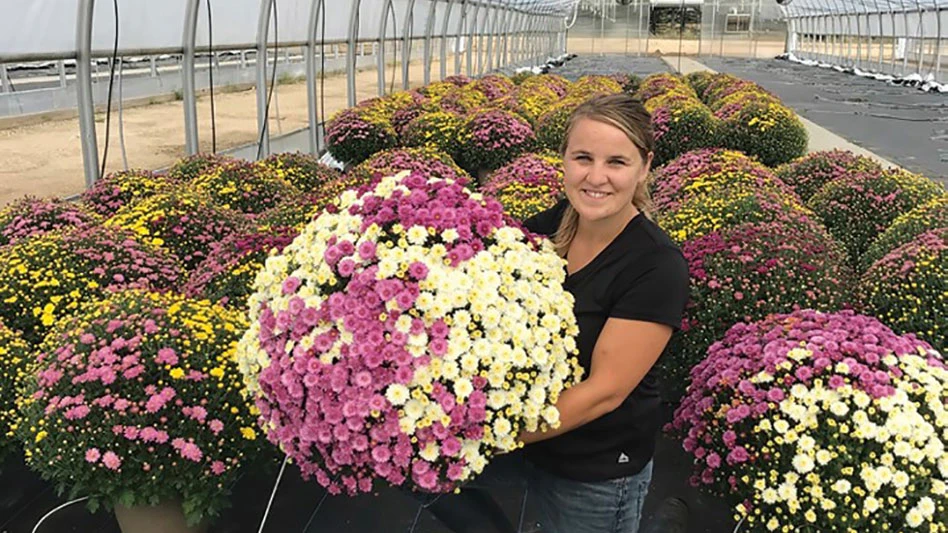
_fmt.png)
Since Candice Abseliamov joined Bergen’s Greenhouses in 2010, the facility has grown from less than 10 acres to 24. Along the way, Abseliamov helped implement new programs and beneficial changes to grow more efficiently. As she’s learned, when managing all the moving parts involved in greenhouse growing, little improvements can add up over time.
Abseliamov joined Bergen’s as a grower assistant 10 days after graduating from Central Lakes College with a degree in horticulture, greenhouse production and floral design. Two days later, the head grower had a baby, and Abseliamov suddenly became a section grower tending five acres of greenhouses. In 2013, she moved into her current role as head grower/greenhouse manager.
“My main focus is to improve the efficiency, safety and cost of everything we do in the greenhouse,” she says. “A lot of small things can make a big difference, from hoses down to the breakers and shutoff valves we use. Those little things make a big impact.”
_fmt.png)
Managing seasonal labor
Bergen’s Greenhouses operates three facilities in Minnesota — Detroit Lakes is responsible for plug production, Forest Lake is focused on annuals, and at Park Rapids, Abseliamov grows perennials, spring annuals and fall mums for clients like Sam’s Club, Walmart, Lowe’s and Aldi.
At the Park Rapids facility, Abseliamov oversees 24 acres of greenhouses, which Bergen’s expands almost every year. While the company employs a small team of five to seven year-round staff, most of Abseliamov’s growing support consists of seasonal help from up to 10 exchange students in the J-1 visa program.
“Almost every year, we get a different group of people, so I have to train them every year,” she says.When the students arrive in February, Abseliamov gives them a tour of the greenhouse and demonstrates how to water plants, mix chemicals, open vents, and fix hoses. Then, she assigns each student a two-acre section of crops to manage until they leave in the fall.
“My job is making sure everybody’s on the right track, so they don’t have to make big decisions they’re unsure of,” says Abseliamov, who writes out detailed instructions and checks in with section growers daily. Throughout the day, she uses Facebook Messenger to conveniently reach growers across the property.
In 2015, one of the J1 workers from Ukraine, Timur Abseliamov, took a special interest in growing — and in Candice. They married three years later, and now work side-by-side in the greenhouse.
_fmt.png)
Bringing in beneficials
Around 2020, when Abseliamov was expecting their first child, she was concerned about chemicals and long restricted entry intervals (REI) associated with greenhouse pesticide applications. While searching for safer alternatives, she stumbled upon biological controls from Koppert.
“We started putting swirski sachets on our mums for thrips and sprinkling Spidex for our spider mites,” she says. “We’ve tweaked our program through the years to be more cost effective, so we use biologicals when plants are pot-tight, filling the pot about 75%, so we don’t waste them on the ground.”
Beneficial insects like orius also help control thrips on Bergen’s pepper plants in the spring. Biocontrols and “friendly chemicals” have replaced harsher pesticides, welcoming more predatory bugs into the greenhouse.
“I’ve noticed that native predators like natural lacewings are coming into the greenhouse now,” Abseliamov says. “By using bios, we’re actually inviting more beneficials to come in and help us.”

_fmt.png)
_fmt.png)
Saving time
Beyond big initiatives like biocontrols, Abseliamov and her husband move the greenhouse forward in small steps, like spacing plants more effectively and adding automatic vents to new greenhouses instead of manual cranks.
They replaced drip tape irrigation with drip tubes to conserve time and water by ensuring that irrigation actually lands in the pot. Similarly, they added individual irrigation boxes for each greenhouse, with a hose for every downspout.
“Before, we just had one hose that you had to drag along a 435-foot greenhouse,” she says. “We used to have one irrigation box shared between three greenhouses, and you’d have to wait six hours for the last house to get watered.”
Hanging baskets more efficiently has been another timesaver. They used to hang baskets one at a time using a long pole, which could take a whole day. Now, they use a forklift platform that holds three people, “so it takes an hour to hang 1,600 baskets in a 15,000-square-foot greenhouse,” Abseliamov says. “I know this doesn’t sound like a lot, but convenience really saves time, little by little. Instead of dragging hoses around, growers have more time to spend watering the ends, pulling weeds or doing chemical applications.”
These timesavers make crews more productive during the day, while giving them time back for themselves at the end of the day. “The greenhouse list of things to do is endless,” Abseliamov says. “As much as you love it, you need to take time for yourself and your family, or you’ll burn out.”

Explore the March 2023 Issue
Check out more from this issue and find your next story to read.
Latest from Greenhouse Management
- Trends: Proven Winners 2025 perennial survey shows strong demand
- Online registration opens for the 2025 Farwest Show
- Sustainabloom launches Wholesale Nickel Program to support floriculture sustainability
- Be the source
- pH Helpers
- Society of American Florists accepting entries for 2025 Marketer of the Year Contest
- American Horticultural Society welcomes five new board members
- Color Orchids acquires Floricultura Pacific, becoming largest orchid supplier in U.S.






